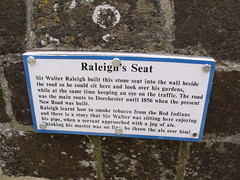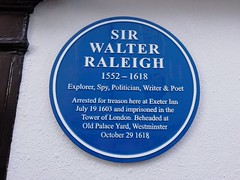Sir Walter Raleigh


Sir Walter Raleigh
(1554-1618)
aristocrat, writer, poet, soldier, courtier, explorer, introducer of tobacco to England, and Knight Bachelor (from 1585)
Commemorated on 3 plaques
Eagle House. A fine Queen Anne house built in the dutch style, in 1706, probably for Ferando Mendez, a Royal Physician. The land was originally owned by Walter Raleigh. In Victorian times, it was part of the Holborn Union Workhouse School
224 London Road, Mitcham CR4 3HD, London, United Kingdom where they owned land
Raleigh's Seat Sir Walter Raleigh built this stone seat into the wall beside the road so he could sit here and look over his gardens, while at the same time keeping an eye on the traffic. The road was the main route to Dorchester until 1856 when the present New Road was built. Raleigh learnt how to smoke tobacco from the Red Indians and there is a story that Sir Walter was sitting here enjoying his pipe, when a servant approached with a jug of ale. Thinking his master was on fire he threw the ale over him!
Raleigh's Seat - Sherborne Castle & Lakeside Gardens, Sherborne, United Kingdom where they built this stone seat into the wall beside the road
Sir Walter Raleigh 1552-1618 Explorer, Spy, Politician, Writer & Poet Arrested for treason here at Exeter Inn July 19 1603 and imprisoned in the Tower of London. Beheaded at Old Palace Yard, Westminster October 29 1618
26 West St, Ashburton, United Kingdom where they was arrested (1603)



